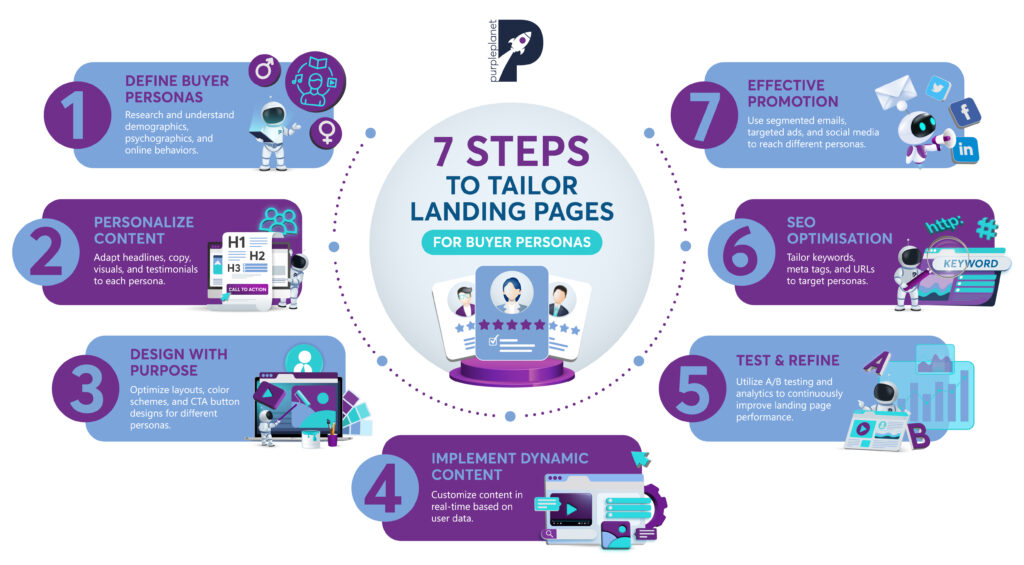

How to Tailor Landing Pages for Different Buyer Persona

Why should you tailor landing pages to buyer personas?
Personalising landing pages to cater to different buyer personas is crucial for enhancing user engagement and conversion rates. This approach allows businesses to speak directly to the unique needs, preferences, and pain points of each visitor, making the content more relevant and engaging.
When a landing page resonates with a visitor, it creates a stronger connection and fosters trust, which is essential in guiding the visitor through the conversion funnel. Furthermore, personalisation makes the user feel valued and understood, which enhances the overall user experience, leading to higher satisfaction.
This tailored approach also allows for clearer and more compelling calls-to-action, as they can be customised to echo the specific desires and requirements of each audience segment.
Personalised landing pages are also more SEO-effective because they can be optimised for the particular keywords and phrases used by each buyer persona, increasing the chances of attracting quality, targeted traffic.
In a digital landscape saturated with generic content, personalisation stands out as a powerful tool to cut through the noise, capture attention, and convert visitors into customers by delivering what they truly want and need.
This article explores how you can tailor your landing pages to different buyer personas and audience segments, helping you to reach new levels of engagement.
Let’s dive in:
What is a buyer persona?
A buyer persona is a semi-fictional representation of an imagined customer based on market research and real data about existing customers. By understanding the different needs, motivations, and behaviours of these personas, businesses can tailor their messaging and offerings more effectively.
For example, a software company might have one persona representing a tech-savvy start-up founder and another representing a non-technical small business owner. These imagined customers will have different needs and understandings of the product on offer, so separate marketing techniques and messages are required.
Landing pages are just one of these avenues that can be enhanced with the use of a buyer persona. Whether the landing page is promoting a product, event, or newsletter, it can be adapted to address the pain points of different customers.
For example, a company selling a new sofa may create one landing page for an older demographic and one for families. If the sofa can be marketed to both groups, why not maximise the opportunities for conversion and design two different web pages?
Businesses may also want to personalise the way in which they promote their landing pages, but we’ll get into that later.
Dynamic vs tailored landing pages
Dynamic landing pages are web pages that automatically adjust their content, appearance, and structure in real-time to cater to the individual needs and preferences of each visitor.
They utilise various parameters like user location, behaviour, device type, or source of traffic to personalise the content. This personalisation can make the page more relevant and engaging for the visitor, enhancing their experience.
In contrast, tailored landing pages do not necessarily have to be dynamic. They could be designed with an audience in mind but be static.
Both types of customisation are instrumental in boosting engagement and conversion, but dynamic pages take it that one bit further.
For businesses, dynamic landing pages can be particularly valuable as they can significantly improve conversion rates. Since the content is more closely aligned with the user’s interests and needs, visitors are more likely to take desired actions such as making a purchase or signing up for more information.
Moreover, dynamic landing pages can also improve the performance of online advertising campaigns by creating a more cohesive and relevant user journey from the ad to the landing page.
Though dynamic landing pages serve as a powerful tool for businesses looking to tailor their messaging, the data they use must be accurate if they are to fulfil their true purpose.
Successful dynamic landing pages
Netflix, Spotify, Amazon, and Airbnb are examples of popular online platforms that effectively utilise dynamic landing pages to optimise user experiences and engagement. These platforms
alter the user interface and content in real-time, ensuring that each visitor encounters a page that is both personalised and immensely relevant:
- Netflix uses this technology to curate and showcase films and series that align with users’ viewing histories and preferences, facilitating a customised browsing experience that enhances viewer satisfaction and promotes continued engagement.
- Spotify employs dynamic landing pages to tailor music and playlist recommendations according to individual listening habits and preferences. This personalised approach fosters a unique listening experience, encouraging user engagement and discovery of new music.
- Amazon leverages dynamic landing pages to display products and offers based on users’ browsing histories and buying behaviours, making the shopping experience more relevant and user-friendly.
- Airbnb uses dynamic landing pages to present property listings and experiences that align with users’ past searches, preferences, and interactions, ensuring that users find options that resonate with their travel needs and preferences.
Through the use of dynamic landing pages, these platforms can provide a more individualised and captivating user experience, driving user satisfaction, loyalty, and overall platform engagement.
Despite the reputations of these successful sites, your landing pages don’t have to be dynamic to offer a relevant user experience.
How to tailor landing pages for different buyer personas in 7 steps
Tailoring your landing pages to different buyer personas will be a clever strategic decision that enhances user engagement and conversion rates. To achieve your goals, consider the following steps:
1. Clarify your buyer personas
To effectively tailor landing pages, it’s essential to first clarify and deeply understand your buyer personas. This process begins with thorough research aimed at identifying and grasping the distinct characteristics and needs of each persona segment.
Check out our in-depth guide on creating buyer personas, if you haven’t already.
Delving into the specifics of your buyer personas means not only understanding their demographics – such as age, gender, location, income, and occupation, but also their psychographics – their interests, challenges, and core values.
Don’t forget to factor in their online behaviours, such as browsing habits, motivations behind purchases, and the channels they frequent. Only with this comprehensive understanding can you truly customise your landing pages to resonate with each persona effectively.
2. Customise the landing page content
Crafting an effective landing page means resonating with your audience on a personal level. To achieve this, the content must be meticulously customised to cater to the unique preferences and needs of each buyer persona:
- Start by adjusting your headlines and subheadings; they should pinpoint and address the distinct interests and requirements of each segment.
- When you’re developing the copy, it’s essential to dial into each persona’s pain points and motivations. Using familiar language and terms ensures that your message hits home and feels bespoke.
- The visual elements, like images and videos, should not be generic. Choose media that mirrors the lifestyle, aspirations, or challenges of the persona, making the content relatable and authentic.
- Integrating testimonials that echo the sentiments of specific personas further validates your offerings and builds trust, because audience segments typically share similar values and pain points.
- The call-to-action (CTA) should attention and align with each persona’s aspirations, nudging them closer to conversion.
3. Consider the design elements
The design of a landing page shouldn’t be a one-size-fits-all approach. The layout of the page can significantly influence a user’s journey and interaction. Different personas might have diverse browsing habits or expectations, so experimenting with various layouts can help in identifying which format resonates most with each group.
Colour schemes tap into the psychology of users. So, use colours that not only represent your brand but also align with the emotional and psychological triggers of your personas.
CTA buttons must be given meticulous attention. A subtle change in design, colour, or text can make a significant difference in click-through rates. By personalising these buttons to cater to the specific interests and inclinations of each persona, you can make them more enticing and effective.
4. Leverage dynamic content
Dynamic content is a game-changer for landing pages, offering a sophisticated way of engaging visitors in a more personalised manner. Your landing pages don’t have to be dynamic to be “tailored,” but it’s a fantastic way of personalising your messaging.
If you choose to create a dynamic landing page, ensure the data it relies on is as accurate as possible, because users can get fed up with irrelevant recommendations.
5. Test and improve
Testing and continuous improvement are crucial elements in ensuring that landing pages remain effective and resonant with their intended audience.
To get the most out of your landing pages over time, consider doing the following:
- A/B testing helps to pinpoint what truly appeals to your audience. Test different elements, one at a time, and repeat the process to keep up with industry changes.
- Analytics such as bounce rate, time spent on the page, and conversion rate will provide invaluable insights into what’s working and what’s not. Always value these indicators and make data-driven improvements.
- Surveys and feedback are ways to engage directly with your audience. Use on-page surveys or feedback forms to gather insights into user experience and potential pain points.
6. Optimise for SEO
SEO is a crucial tool for boosting a landing page’s visibility, ensuring it reaches the intended audience. When tailoring for specific buyer personas, the nuances in optimisation become even more essential:
- Make sure your keyword research identifies the terms and phrases your target audience is searching for.
- Analyse the landing pages of your competitors.
- Ensure that the landing page’s title and meta descriptions incorporate the primary keyword and resonate with the persona’s intent.
- Ensure your keywords are integrated naturally and not stuffed in.
- Use H tags effectively, including relevant keywords where possible.
- Keep your URL structure clean and concise.
- Bolster your site’s overall authority with an internal linking strategy.
- Optimise your images for size and loading speed.
The landing page’s content should always prioritise the user experience and be relevant to the buyer persona.
7. Promote your pages
Not all audiences interact with content in the same way, and understanding this is key to effective promotion. Depending on your buyer persona’s internet habits, you may want to promote your landing page in different ways.
There are several ways you can promote your landing page, and utilising multiple methods can ensure all audience segments are engaged.
For example:
- Segmented email campaigns: Segment your email mailing list based on criteria like purchase history, demographics, or engagement level. This allows you to send personalised emails with links to landing pages designed specifically for each buyer persona.
- Targeted advertising: Create targeted ad campaigns with Facebook, Google Ads, or LinkedIn. Knowing where your buyer personas frequently engage online can drastically improve ad performance.
- SEO: Landing pages can be optimised for specific keywords a particular buyer persona may search, directing them to your targeted landing page.
- Direct or referral traffic: Sharing a landing page link directly with strategic partners, affiliates, or in niche forums where a target persona frequents can drive specialised traffic.
- Social media promotion: Different buyer personas may favour different social media platforms. Use your research to promote your landing pages in the most relevant channels.
Final thoughts
By tailoring landing pages to meet the specific needs and interests of each buyer persona, businesses can create more personalised and satisfying user experiences, which can boost conversion rates, customer happiness, and overall marketing effectiveness.
To learn how buyer personas can elevate entire marketing campaigns, check out our in-depth guide.











